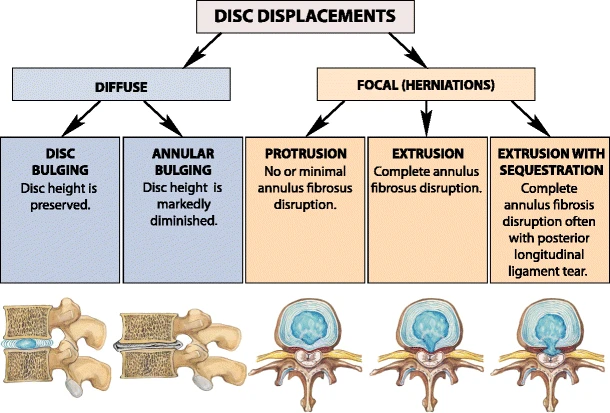Spinal Disc Injuries
Back pain is one of the most common reasons people visit a doctor or physical therapist. Approximately 80–90% of low back pain cases are classified as nonspecific, meaning no clear pathoanatomic source can be identified; this includes cases where muscle, ligament, or other soft tissue sources are suspected but not definitively proven. Among cases where a specific source is identified, intervertebral disc injury (including discogenic pain and herniation) is the most common, accounting for 29–49% of chronic low back pain cases.
What is the intervertebral disc?
Your spine is made up of 24 bones (vertebrae) stacked on top of each other. Between each bone sits a disc, which acts like a cushion or shock absorber.
Each disc has two parts:
A soft, gel-like center that absorbs pressure.
A tougher, outer ring that keeps the center in place.
Disc Injury - There are 4 types of disc injuries: disc bulging, disc protrusion, disc extrusion, and disc sequestration.
Disc bulging refers to a generalized extension of the annular tissue beyond the normal margins of the disc space
Disc protrusion is characterized by focal displacement of disc material where the base of the displaced material is wider than its outward extent
Disc extrusion occurs when the displaced disc material extends further than the width of its base, often resulting in more pronounced nerve root compression and radicular symptoms
Disc sequestration describes a scenario where the extruded disc fragment loses continuity with the parent disc, potentially migrating within the spinal canal and causing severe neurological deficits
** there are other disc-related structural changes and injuries that may lead to discogenic pain like tears and degenerative changes.
The Intervertebral Disc - A Tissue With Bad Reputation
For many people, the word “disc” immediately brings fear. Discs often get a bad reputation because terms like “slipped disc” or “degenerative disc disease” sound alarming. In reality, disc changes are a very normal part of aging, and many people with disc bulges or degeneration have no pain at all. An MRI might show a disc issue, but that doesn’t automatically mean it’s the cause of your symptoms or that you need surgery. Understanding that discs are resilient, adaptable structures—not fragile ones—can help take away some of the fear that often comes with a disc diagnosis.
The Disc As A Resilient Structure
The natural healing process of intervertebral disc injury in the back is characterized by a high rate of spontaneous symptom improvement and radiographic regression over time, especially for herniated discs, extrusions, and sequestrations. Most patients experience substantial pain reduction within weeks to months of conservative management, with 87% reporting decreased pain at 3 months and up to 76% of herniated discs showing partial or complete resolution on MRI by 1 year
Exercise - A Key For Disc Adaptation
Exercise—particularly dynamic, axial loading at moderate intensity such as walking, jogging, or running—has been shown to increase disc hydration, proteoglycan content, and disc height, reflecting improved disc material properties and hypertrophy in both healthy individuals and those with disc injury. Exercise also improves nutrient diffusion and fluid flow within the disc, which is critical for disc cell metabolism and waste removal, especially in the context of injury and healing. These adaptations are dose-dependent (one size not fit all).
Experiencing Back Pain around Carmel Valley, San Diego?
Book a free phone consult today

